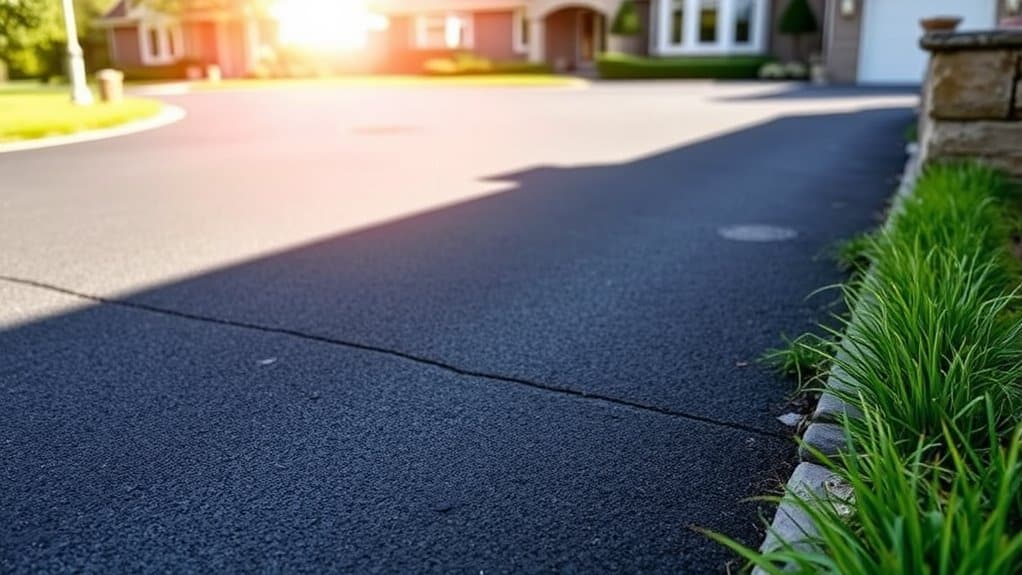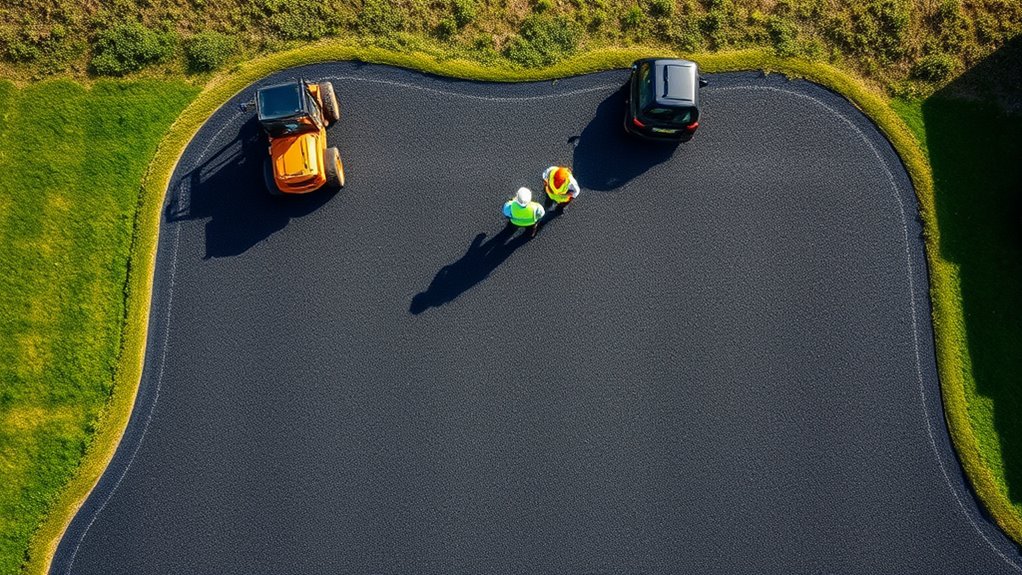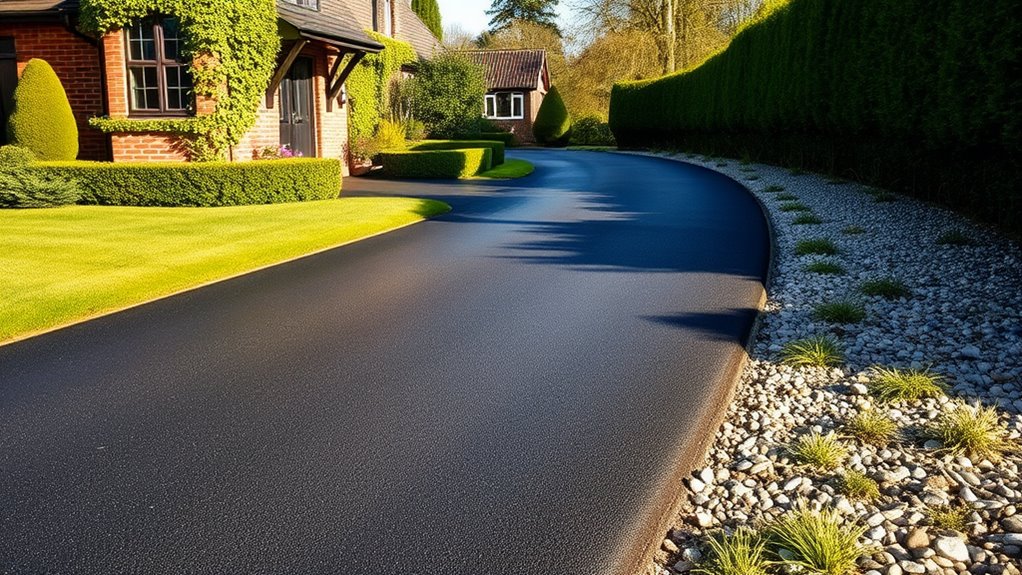To improve traction on your tarmac driveway in wet conditions, start by ensuring a solid base and proper grading for water runoff. Use polymer-modified asphalt and maintain a higher stone-to-bitumen ratio for better durability. Once laid, apply a quality tarmac sealer and consider anti-slip coatings for extra grip. Regular maintenance, such as cleaning and fixing cracks, is vital for maintaining traction. For further safety enhancements, look into innovative materials and methods.
Table of Contents
ToggleKey Takeaways
- Increase the stone-to-bitumen ratio in the mix to improve grip and stability on wet surfaces.
- Apply a textured anti-slip coating for better traction when it rains.
- Regularly clean the driveway to remove debris and moss that can cause slipping.
- Seal the tarmac with a quality sealer to protect against moisture and wear.
- Consider adding a gravel overlay to enhance friction and facilitate water drainage.
PreLaying Surface Preparation
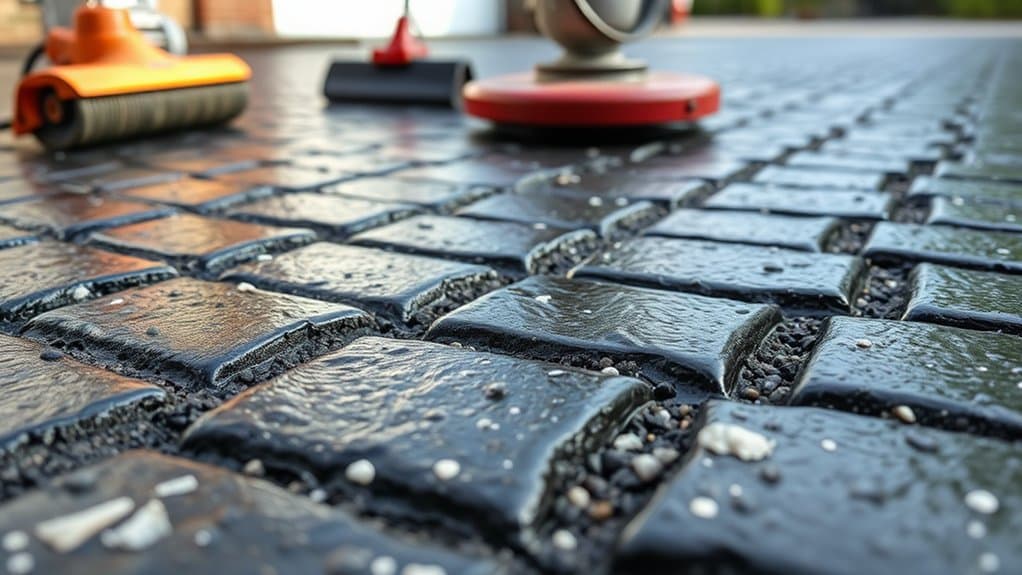
Before laying a tarmac driveway, proper surface preparation is crucial for durability and performance. Start by ensuring the base is stable; this involves compacting the subsoil thoroughly. Remove any debris, vegetation, or existing materials that could weaken the foundation. A strong base layer is essential for load-bearing capacity, which supports vehicle weight and maintains the driveway’s integrity.
Moisture control is vital—check the soil conditions to ensure it’s dry, as excess moisture can affect bonding and weaken the surface. If necessary, install a geotextile membrane for added stability. Additionally, laying tarmac in ideal weather conditions is essential for achieving a durable surface.
Grade the area correctly to ensure effective water runoff, directing moisture away from the driveway. Regularly inspect nearby storm drains or gutters for blockages.
Materials and Mix Design

When choosing materials for a tarmac driveway, it’s important to consider how different components work together to improve traction and durability. A well-formulated mix not only enhances performance but also prolongs the lifespan of your driveway.
- Rest easy knowing your driveway can handle wet weather.
- Enjoy the confidence that comes from excellent traction.
- Trust that your surface will remain durable and stable.
- Benefit from a driveway that minimises slipping risks.
Focus on selecting the right aggregates to maximise traction. Polymer-modified asphalts can provide flexibility, while porphyry aggregates improve friction. Additionally, consider the weather resistance of your materials to ensure they can withstand extreme conditions and maintain traction. It’s also essential to use a higher stone-to-bitumen ratio in your mix to enhance stability and grip.
Ensure an appropriate bitumen content for stability and maintain adequate air voids for drainage, which further enhances traction in wet conditions.
Post-Laying Treatments

To ensure your tarmac driveway lasts and performs well, it’s important to apply post-laying treatments.
Start with a tarmac sealer like TarmaSeal Tarmac Restorer when the surface is dry and clean. The ideal application temperature is above 12 degrees Celsius, and it’s best to choose a day with no rain forecasted. A key preparation step is to clean surface thoroughly before applying the sealer. Regular sealing helps to extend lifespan by protecting against environmental damage.
A 20-litre drum typically covers 40-60 square metres, and for optimal results, apply two coats with a 2-4 hour gap between them.
You might also want to consider adding traction features, such as textured surfaces or anti-slip coatings, to improve grip.
These treatments not only make your driveway look better but also increase its durability, especially in wet weather.
Maintenance Strategies
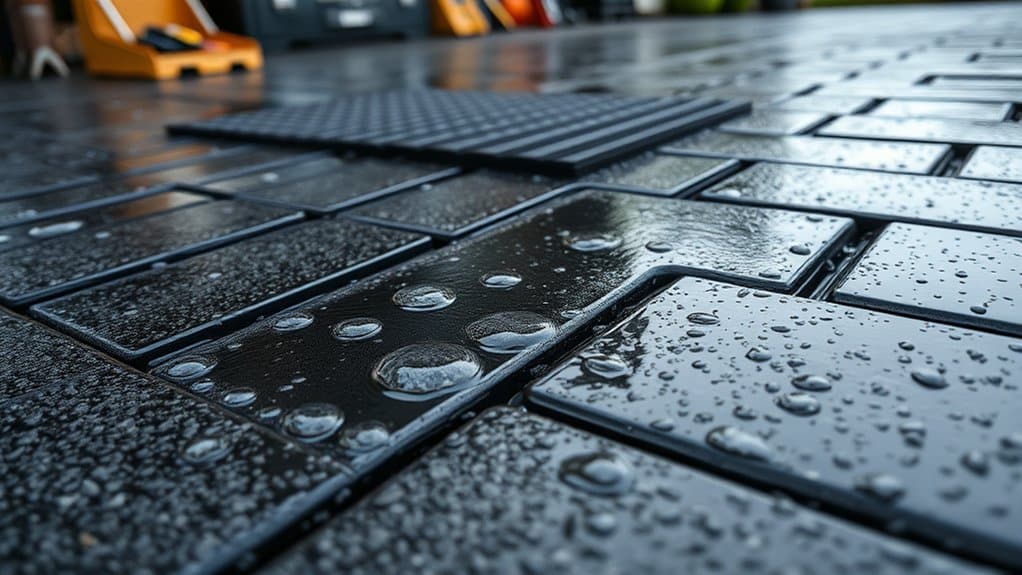
Effective maintenance strategies are vital for keeping your tarmac driveway in top condition. Regular upkeep not only improves traction but also helps avoid expensive repairs.
Use proper cleaning methods to remove oil and debris, and ensure moss is cleared away to prevent surface damage. Regularly check for cracks or potholes and address them quickly to maintain the driveway’s integrity.
- Feel confident knowing your driveway is safe.
- Enjoy a tidy appearance that enhances your home.
- Safeguard your investment from weather-related harm.
- Have peace of mind with a dependable surface.
Check drainage systems regularly to stop water pooling, which can weaken the tarmac.
Seasonal Preparation

As you prepare for each season, focus on essential tasks to keep your tarmac driveway in top shape.
In winter, take precautions against freeze-thaw cycles to prevent damage.
Spring is the time for a thorough maintenance check to fix any wear and tear.
In autumn, manage debris like leaves and twigs to avoid hazards and ensure your driveway remains safe and functional all year round.
Winter Weather Precautions
Winter brings its own charm, but it can also create challenges for your tarmac driveway. Here are some straightforward tips to ensure your driveway is winter-ready:
- Protect your family from slips and falls.
- Extend the life of your driveway against harsh conditions.
- Ensure accessibility for vehicles and guests.
- Prevent expensive repairs from winter damage.
Begin by sealing any cracks and cleaning the surface to stop ice from forming.
Use non-corrosive de-icers like magnesium chloride, and clear snow promptly with a plastic shovel to avoid compaction.
To improve traction in slippery spots, sprinkle sand or kitty litter.
Spring Maintenance Checklist
To keep your tarmac driveway in top condition this spring, follow this maintenance checklist.
Start with a thorough spring clean by sweeping away any debris left from winter.
Next, check the drainage to ensure water flows correctly and doesn’t pool, which can lead to further issues.
Inspect for cracks and potholes, sealing them promptly with the right fillers or cold-lay tarmac as needed.
Ensure the base layer is stable to support the surface.
Remember to clear gutters and treat weeds along the edges, as these can cause damage over time.
Regularly pressure wash your driveway every 3-6 months to improve its appearance and grip, and apply moss inhibitors in spring to prevent growth and reduce slip hazards.
Autumn Debris Management
After completing your spring maintenance checklist, it’s crucial to shift your focus to autumn debris management to keep your tarmac driveway safe. Leaf build-up and organic debris can create slippery surfaces, making regular removal essential.
- Prevent stains that affect traction
- Reduce moisture that encourages moss and algae growth
- Ensure a clean surface for better grip
- Protect your driveway’s integrity
Increase the frequency of leaf clearance to avoid moisture accumulation. Regular sweeping not only enhances the tarmac’s texture but also prevents weeds and structural problems at the edges.
Use drying techniques after cleaning to keep the surface safe. By effectively managing autumn debris, you can ensure your tarmac driveway remains safe and functional throughout the wet season.
Safety and Accessibility Enhancements

Implementing safety and accessibility enhancements on your tarmac driveway reduces hazards and promotes a secure environment for everyone.
Regularly clearing drainage systems ensures water flows freely, preventing slippery conditions. Carry out slip resistance testing to pinpoint areas needing traction improvements. You can apply sealants with traction-enhancing additives or use textured overlays for better grip.
Installing proper lighting, such as solar-powered or motion-sensitive lights, improves visibility during low-light conditions. Additionally, maintaining surrounding landscaping and designing the driveway with a slight incline helps with water runoff, reducing standing water.
Keeping sand or traction mats on hand provides immediate solutions for unexpected wet conditions, reinforcing safety for all users.
Long-Term Solutions for Enhanced Traction
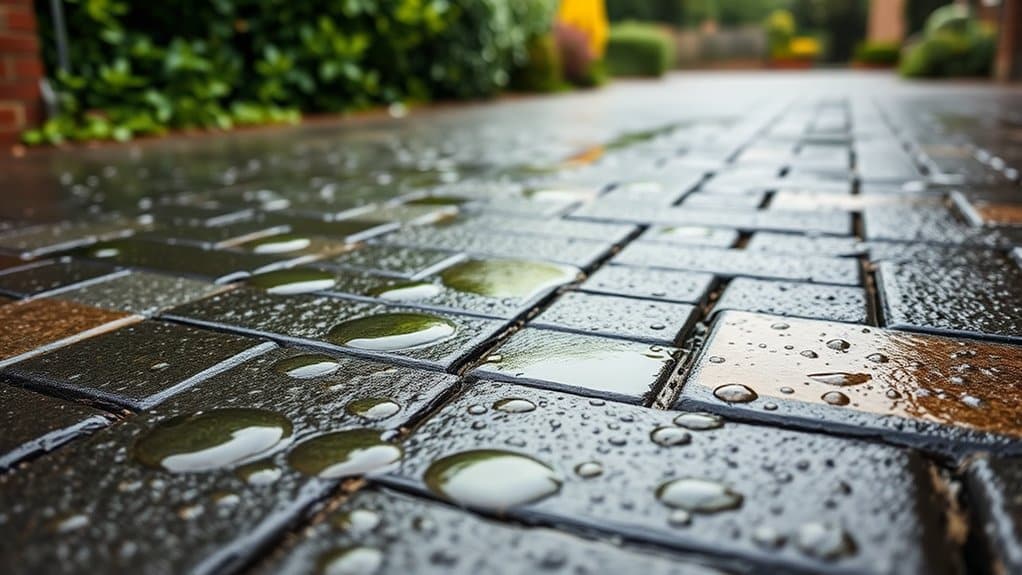
When improving traction on your tarmac driveway, it’s crucial to consider long-term solutions for sustainable safety and usability.
Here are some effective strategies:
- Resurfacing with high-quality asphalt offers durability and enhanced skid resistance.
- A tar and chip driveway provides a cost-effective, textured surface for better grip.
- Resin-bound driveways allow for water permeability, reducing puddles and improving traction.
- Adding a gravel overlay can increase friction, making for a safer driving experience.
These methods not only enhance traction but also take environmental factors into account.
Frequently Asked Questions
How Often Should I Sealcoat My Tarmac Driveway?
You should sealcoat your tarmac driveway every 2 to 5 years, depending on usage and weather conditions. Regular maintenance helps protect against damage and can significantly extend the life of your driveway. For example, if your driveway sees heavy traffic or is exposed to harsh weather, aim for the shorter interval.
What Are the Signs of a Slippery Tarmac Surface?
A slippery tarmac surface can be identified by its smooth texture, pooling water, and visible stains. To maintain safe traction, it’s essential to conduct regular inspections and promptly address any wear. This helps prevent hazardous conditions, particularly in wet weather.
Can I Use Regular Asphalt for Better Traction?
Did you know that textured surfaces can improve traction by as much as 30%? Using standard asphalt combined with additives like calcined bauxite boosts grip, making the surface safer in wet weather and significantly lowering the risk of hydroplaning.
How Do Weather Conditions Affect Driveway Traction?
Weather conditions significantly affect driveway traction. For instance, rain can make surfaces slippery, increasing the risk of slips and falls. Similarly, temperature changes and humidity can impact the durability of materials used in driveways. For example, frost can cause cracks in asphalt, compromising grip. Understanding these factors is crucial for enhancing traction, ensuring both safety and the longevity of your driveway.
Is Tarmac Suitable for Steep Driveways?
Tarmac isn’t the best choice for steep driveways because it lacks durability and slip resistance. For better traction and longevity, consider alternatives like block paving or resin driveways. These options not only enhance safety but also minimise maintenance issues on inclined surfaces.
Conclusion
To improve the traction of your tarmac driveway in wet conditions, focus on proper preparation, good quality materials, and consistent maintenance. By using the right techniques, your driveway can provide reliable grip, ensuring safety even when it’s wet. Regularly check your surface for wear and treat it as needed to maintain its traction. Additionally, consider seasonal adjustments to enhance performance during rainy months. By following these straightforward strategies, you’ll boost safety and accessibility for years to come.
Just how long can you expect your tarmac driveway to last? Discover key factors and maintenance tips that can extend Read more
From planning to final touches, discover the essential steps of tarmac driveway installation—what could go wrong if you skip any Read more
Wondering if a tarmac driveway is the perfect fit for your home? Uncover the essential pros and cons before making Read more


